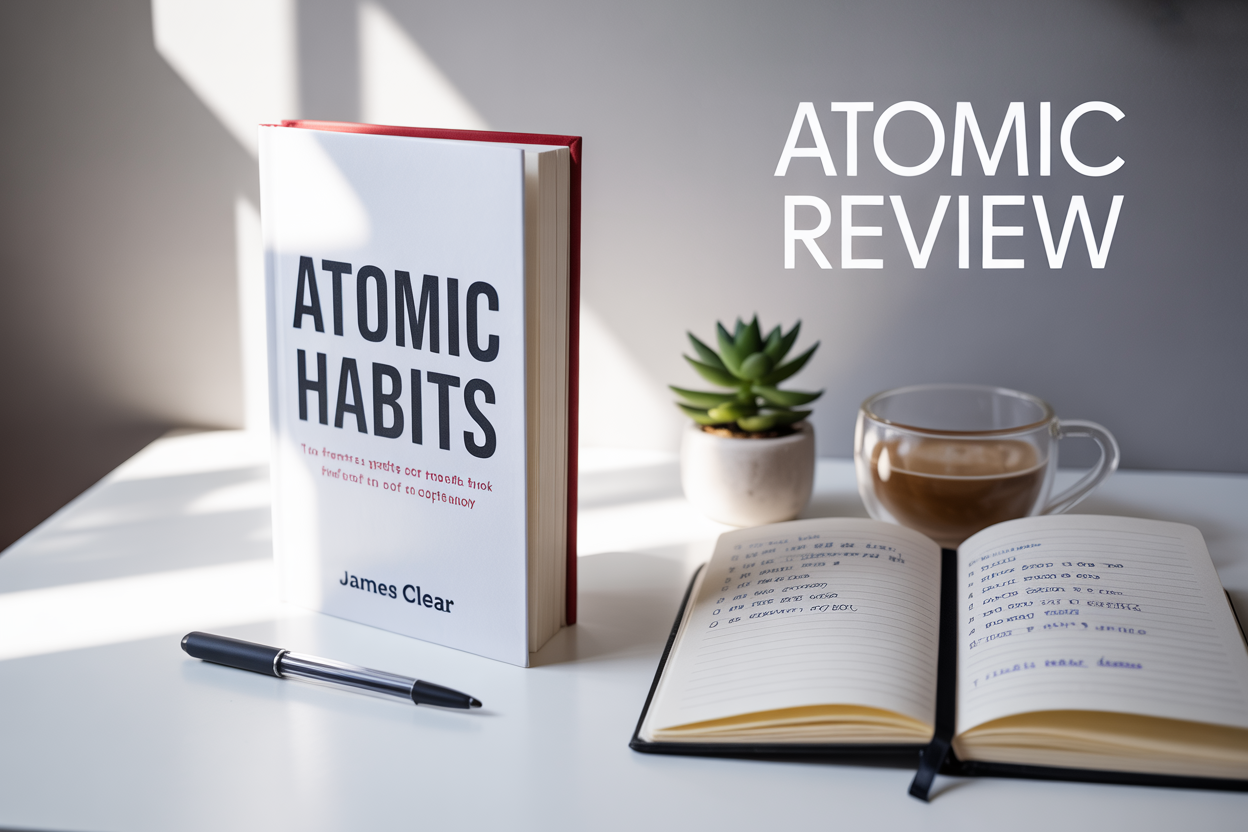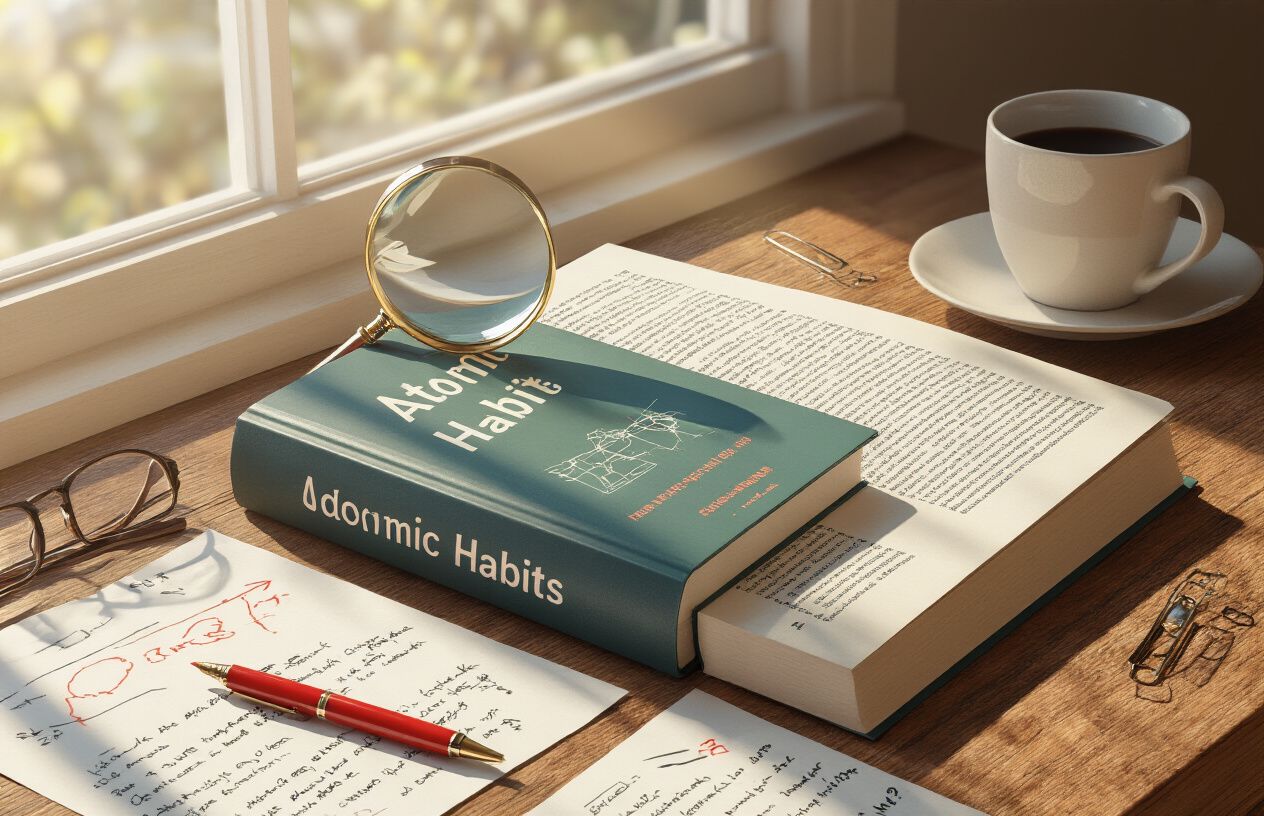Book Review – Atomic Habit by James Clear

Atomic Habits by James Clear: A Complete Book Review
James Clear’s “Atomic Habits” has become the go-to guide for anyone struggling to build good habits or break bad ones. This book review breaks down Clear’s proven system for creating lasting behavioral changes through small, incremental improvements.
Perfect for busy professionals, students, and anyone tired of failed New Year’s resolutions, this review cuts through the hype to show you what actually works. You’ll discover Clear’s Four Laws of Behavior Change that make habit formation almost automatic, plus real strategies you can start using today.
We’ll cover Clear’s core framework that turns habit-building into a simple four-step process, examine the key concepts that separate successful habit-changers from serial quitters, and look at practical ways to apply these ideas in your daily life. You’ll also get an honest take on where the book shines and where it might fall short.
If you’re wondering whether “Atomic Habits” lives up to its reputation or just want to understand the main ideas before diving in, this review gives you everything you need to know.
Book Overview and Author Background

James Clear’s Expertise in Habit Formation
James Clear built his reputation as a habit formation expert through years of personal experimentation and extensive research into behavioral psychology. His journey began when a baseball injury in high school forced him to rebuild his life from scratch. This experience sparked his fascination with the science of small improvements and consistent habits.
Clear’s background combines practical experience with rigorous study of behavioral science research. He spent years analyzing studies from psychology, neuroscience, and behavioral economics to understand what makes habits stick. His approach differs from many self-help authors because he grounds his advice in scientific evidence rather than motivational rhetoric.
Before writing Atomic Habits, Clear established himself through his popular newsletter and website, where he shared insights about habit formation with millions of readers. His writing style translates complex psychological concepts into actionable strategies that regular people can actually implement.
Core Premise of the 1% Improvement Philosophy
The book revolves around a deceptively simple concept: getting just 1% better each day leads to remarkable results over time. Clear illustrates this through compelling math – if you improve by 1% daily for a year, you’ll be 37 times better. Conversely, declining by 1% daily leaves you with nearly nothing.
This philosophy challenges the common belief that massive changes produce the best results. Instead, Clear argues that small, consistent improvements compound over time to create extraordinary outcomes. He uses the metaphor of ice melting – nothing seems to happen at 25, 26, or 31 degrees, but at 32 degrees, everything changes.
The 1% rule applies to all areas of life, from fitness and learning to relationships and career development. Clear emphasizes that these tiny changes seem insignificant in the moment, which is why people often abandon them. However, the compound effect makes them incredibly powerful over months and years.
Target Audience and Book’s Intended Impact
Atomic Habits speaks to anyone struggling with building good habits or breaking bad ones. Clear specifically targets people who have tried and failed to change their behavior before. He understands the frustration of setting ambitious goals only to abandon them within weeks.
The book appeals to diverse audiences: professionals seeking career advancement, athletes improving performance, students developing study habits, and individuals working on personal development. Clear’s approach works regardless of age, background, or current circumstances.
Rather than promising an overnight transformation, Clear aims to shift readers’ entire relationship with change. He wants people to stop relying on motivation and willpower, focusing instead on designing systems that make good habits inevitable. The book’s impact comes from its practical framework that readers can immediately apply to any area of their lives.
Publication Success and Recognition
Published in 2018, Atomic Habits quickly became a phenomenon in the self-improvement space. The book has sold over 15 million copies worldwide and has been translated into dozens of languages. It consistently ranks among the top-selling books on Amazon and other platforms.
The book’s success stems from its unique combination of scientific rigor and practical applicability. Unlike many self-help books that rely on anecdotes, Clear provides a systematic framework backed by research. This approach resonated with readers hungry for evidence-based strategies rather than empty motivation.
Atomic Habits received endorsements from notable figures, including Charles Duhigg, Cal Newport, and Adam Grant. The book has been featured in major publications, and Clear has become a sought-after speaker for conferences and corporate events. The book’s influence extends beyond individual readers to organizations implementing Clear’s strategies for team performance and company culture.
The Four Laws of Behavior Change Framework

Make it obvious – cue identification strategies
Clear breaks down the first law by showing how environmental design drives behavior more than willpower. The key lies in making good habits impossible to ignore while making bad habits invisible. He introduces habit stacking, where you pair a new habit with an existing one using the formula: “After I [current habit], I will [new habit].” For example, “After I pour my morning coffee, I will write three things I’m grateful for.”
Environmental restructuring plays a huge role here. Clear recommends placing visual cues for good habits in obvious places – keeping books on your coffee table if you want to read more, or laying out workout clothes the night before. The opposite works for breaking bad habits: hide your phone in another room, keep junk food out of sight, or remove apps that waste your time.
The author also emphasizes implementation intentions, which involve planning exactly when and where you’ll perform a habit. Instead of saying “I’ll exercise more,” you specify “I will run for 30 minutes at 7 AM in my neighborhood.” This specificity eliminates decision fatigue and creates automatic behavioral triggers.
Make it attractive – craving amplification techniques
The second law focuses on dopamine’s role in habit formation. Clear explains that dopamine spikes not during the reward itself, but in anticipation of it. Smart habit designers leverage this by bundling tempting activities with necessary ones through temptation bundling: “After I check Instagram for 10 minutes, I will read 10 pages of my book.”
The social environment becomes crucial here. Clear highlights how we unconsciously mimic the behaviors of three groups: the close (family and friends), the many (the tribe), and the mighty (those with status and prestige). Joining communities where your desired behavior is normal makes that behavior more attractive. Want to become a runner? Join a running club where everyone talks about their next race.
Reframing your mindset also amplifies attraction. Instead of viewing exercise as something you “have to do,” Clear suggests seeing it as developing skills and becoming the type of person who prioritizes health. This shift from obligation to identity makes habits more appealing and sustainable.
Make it easy – response simplification methods
The third law emphasizes reducing friction rather than increasing motivation. Clear introduces the Two-Minute Rule: when starting a new habit, scale it down until it takes less than two minutes. “Read 30 books this year” becomes “Read one page,” and “Run a marathon” becomes “Put on running shoes.”
Environmental design becomes critical for ease. Clear recommends preparing your environment for success by reducing the steps between you and good habits while increasing the steps for bad ones. Keep healthy snacks at eye level, prep workout equipment the night before, or use smaller plates to eat less without thinking about it.
The concept of “gateway habits” shows how small actions naturally lead to larger ones. Once you put on running shoes, you’re more likely to walk around the block. Once you’re walking, you might decide to jog. The key is starting with the easiest possible version of your desired behavior.
Make it satisfying – reward optimization approaches
The final law addresses the challenge that good habits often have delayed rewards while bad habits provide immediate gratification. Clear suggests adding immediate rewards to good habits – treat yourself to a favorite tea after meditation, or put money in a “vacation fund” after each workout.
Habit tracking serves as both a visual cue and an immediate reward. Clear recommends simple tracking methods like marking X’s on a calendar or using a habit tracker app. The act of recording completion provides instant satisfaction and creates a visual representation of progress.
He also introduces habit contracts, where you create immediate consequences for missing habits. This might involve giving money to a cause you dislike when you skip workouts, or having an accountability partner who checks on your progress. The social cost of breaking commitments often outweighs the temporary pleasure of avoiding good habits.
The satisfaction law also emphasizes celebrating small wins. Clear argues that how you feel after completing a habit determines whether you’ll repeat it. Taking a moment to acknowledge your success, even with something as simple as “I did it!” reinforces the neural pathways that make the habit automatic.
Key Concepts That Transform Daily Performance

Habit Stacking for Seamless Integration
James Clear introduces habit stacking as a brilliant way to anchor new behaviors to existing routines. This technique works by linking a desired habit to something you already do automatically. The formula is simple: “After I [current habit], I will [new habit].” For example, “After I pour my morning coffee, I will meditate for two minutes” or “After I sit down at my desk, I will write down my three priorities for the day.”
The beauty of habit stacking lies in its simplicity and effectiveness. Your brain doesn’t need to remember to do something completely new – it just piggybacks on an established neural pathway. This creates a natural trigger that eliminates the guesswork and decision fatigue that often derail new habits.
The key to successful habit stacking is choosing the right anchor habit. It should be something you do consistently and at roughly the same time each day. The more automatic your anchor habit, the stronger foundation you create for the new behavior. Clear emphasizes starting small – stack tiny habits that take less than two minutes to complete, then gradually build from there.
Environment Design for Automatic Behaviors
Clear reveals how our surroundings shape our actions more than we realize. Instead of relying on willpower, smart environment design makes good habits obvious and bad habits invisible. This concept flips traditional thinking about behavior change on its head.
Making cues visible transforms behavior effortlessly. Place your workout clothes next to your bed, keep healthy snacks at eye level in the fridge, or leave your guitar in the living room instead of tucked away in a case. These visual reminders serve as constant prompts that guide your choices without conscious effort.
The flip side involves removing friction for good habits while adding friction for bad ones. Clear shares examples like freezing your credit cards in ice to prevent impulse purchases or unplugging your TV and removing the batteries from the remote. These small obstacles create just enough resistance to break automatic negative behaviors.
Context matters enormously. Designating specific spaces for specific activities helps your brain associate locations with behaviors. Create a dedicated reading corner, keep your desk clutter-free for focused work, or establish a meditation spot that signals calm and reflection.
Identity-Based Habits Over Outcome-Based Goals
The most powerful shift Clear presents is moving from “I want to lose weight” to “I am a healthy person.” This identity-based approach focuses on who you want to become rather than what you want to achieve. Every action becomes a vote for the type of person you believe yourself to be.
Traditional goal-setting often creates internal conflict. When you say “I want to quit smoking” while still identifying as a smoker, part of you resists the change. However, when you shift to “I am not a smoker,” your actions naturally align with this identity. The behavior becomes self-reinforcing rather than forced.
Small wins compound into identity changes. Each time you choose the salad over fries, you strengthen your identity as a healthy person. Every morning you wake up early reinforces your identity as a disciplined individual. These micro-actions accumulate into genuine self-concept shifts.
The process works both ways – changing your behavior gradually shifts your identity, and adopting a new identity influences your behavior. This creates a positive feedback loop that makes lasting change feel natural rather than forced.
The Compound Effect of Small Consistent Actions
Clear demolishes the myth that transformation requires dramatic action. The compound effect shows how tiny improvements – just 1% better each day – create remarkable results over time. The math is compelling: improving by 1% daily means being 37 times better after one year.
The challenge is that small changes feel insignificant in the moment. Reading for 10 minutes doesn’t make you smarter today. One workout doesn’t transform your body. A single healthy meal doesn’t change your weight. This creates the “plateau of latent potential,” where people give up because they don’t see immediate results.
Breaking through this plateau requires faith in the process and understanding that habits are not about having something, but about becoming someone. The results lag behind the identity change. You might exercise for months before seeing physical changes, but your identity as an athlete develops from day one.
Clear uses the ice cube analogy perfectly. As you heat ice from 25 to 31 degrees, nothing seems to happen. But at 32 degrees, the ice suddenly melts. The breakthrough moment isn’t when you finally see results – it’s the culmination of all the invisible work that came before.
This concept applies everywhere: writing daily builds expertise gradually, consistent networking creates career opportunities over time, and small acts of kindness compound into meaningful relationships. The key is trusting the process when progress feels invisible.
Practical Implementation Strategies from the Book

The Two-Minute Rule for Habit Initiation
James Clear’s two-minute rule stands as one of the most practical strategies in Atomic Habits, designed to eliminate the friction that prevents new habits from taking root. The concept is beautifully simple: when starting a new habit, scale it down until it takes no more than two minutes to complete. Want to read more books? Don’t commit to reading for an hour daily—start with “read one page.” Hoping to exercise regularly? Begin with “put on my workout shoes.”
This approach works because it targets the moment of resistance that kills most habit attempts before they begin. Our brains are wired to avoid activities that seem overwhelming or time-consuming. By shrinking habits to their smallest viable form, you’re essentially tricking your brain into compliance. The two-minute version feels so easy that saying no becomes harder than just doing it.
The genius lies in what Clear calls “mastering the habit of showing up.” Once you consistently perform the scaled-down version, you can gradually expand it. The person who puts on workout shoes daily will naturally start walking around the block. The daily page reader will eventually find themselves reading entire chapters. The rule creates momentum rather than perfection, building the neural pathways that make larger behaviors feel automatic over time.
Habit Tracking Systems That Actually Work
Clear emphasizes that the best habit tracking system is the one you’ll actually use consistently. Complexity kills compliance, so the most effective trackers focus on simplicity and visual clarity. The habit tracker should make progress obvious and provide immediate satisfaction when you mark off a completed habit.
Paper-based systems often outperform digital alternatives because they create a stronger psychological connection to the behavior. A simple calendar with X marks, a journal with checkboxes, or a wall chart can be more powerful than sophisticated apps. The physical act of marking progress creates a small but meaningful reward that reinforces the habit loop.
The key principles for effective tracking include:
- Track only a few habits at once – Start with 1-3 habits maximum to avoid overwhelm
- Make it visible – Place your tracker where you’ll see it daily
- Keep it simple – Use binary tracking (did it/didn’t do it) rather than complex scoring
- Focus on leading measures – Track the behaviors that lead to outcomes, not just the outcomes themselves
Visual tracking works because it provides immediate feedback and creates what Clear calls a “chain of evidence.” Each mark represents proof of your new identity taking shape. Missing a day becomes visually obvious, but the key is never missing twice in a row—a principle that prevents single slip-ups from becoming complete derailments.
Breaking Bad Habits Through Inverse Application
The four laws of behavior change don’t just build good habits—they can demolish bad ones when applied in reverse. Clear’s inversion approach provides a systematic method for eliminating unwanted behaviors by making them invisible, unattractive, difficult, and unsatisfying.
Making it invisible involves removing environmental cues that trigger bad habits. If you want to stop checking social media obsessively, remove the apps from your phone’s home screen or log out after each use. The extra friction of logging back in often provides enough pause to break the automatic response.
Making it unattractive means highlighting the negative consequences of bad habits. Create a motivation ritual where you visualize the costs of continuing the behavior. Someone trying to quit smoking might calculate the annual financial cost and imagine what else that money could buy.
Making it difficult adds friction to unwanted behaviors. Want to stop late-night snacking? Don’t keep tempting foods in the house. Trying to reduce screen time? Put your devices in another room before bed. The added steps required to engage in the habit often eliminate the behavior entirely.
Making it unsatisfying involves creating immediate consequences for bad habits. This could mean having an accountability partner, using commitment devices, or creating habit contracts with financial stakes. The immediate cost helps override the delayed benefits that make bad habits attractive.
The inversion strategy works because it targets the same behavioral mechanisms that create good habits, just in reverse. By systematically removing the environmental and psychological support structure that maintains bad habits, they naturally weaken and eventually disappear.
Real-World Applications and Success Stories

Personal productivity and professional growth examples
Software engineer Sarah transformed her career trajectory by implementing Clear’s habit-stacking technique. She paired reviewing code with her morning coffee ritual, dedicating 20 minutes each day to learning new programming languages. Within eight months, she mastered three frameworks that landed her a senior developer position with a 40% salary increase.
Marketing executive David struggled with procrastination until he applied the two-minute rule. He broke down overwhelming projects into immediate two-minute actions like “open the document” or “write three bullet points.” His team’s productivity metrics improved by 35%, and he received recognition for consistently meeting deadlines.
Freelance graphic designer Maria used environmental design principles to boost creativity. She placed her sketchbook next to her coffee maker and removed her phone from her workspace. This simple change led to 30 minutes of daily sketching before checking emails, resulting in a more diverse portfolio that attracted premium clients.
Health and fitness transformation cases
Personal trainer Jennifer applied atomic habits to her own fitness journey after struggling with consistency. She started with just five push-ups after brushing her teeth each morning. Six months later, this evolved into a complete strength training routine. Her transformation inspired her to develop a client program based on micro-habits, achieving an 85% retention rate compared to the industry average of 20%.
Corporate executive Robert replaced his afternoon energy drinks with a 10-minute walk around the building. He linked this new habit to his existing routine of checking quarterly reports. The walking habit expanded to include weekend hikes, and within a year, he lost 30 pounds and reported significantly improved mental clarity during board meetings.
Busy mother of three, Lisa, used habit stacking to incorporate wellness into her chaotic schedule. She did squats while waiting for her coffee to brew and practiced deep breathing during her children’s bedtime routine. These small habits accumulated into a 45-minute daily wellness practice that helped her manage stress and increase energy levels.
Creative and learning habit development
Aspiring novelist Tom applied the 1% better principle to his writing goals. Instead of attempting to write entire chapters, he committed to writing just one paragraph daily. He tracked his progress visually using a calendar chain, which motivated him to maintain consistency. After 18 months, he completed his first novel and developed a sustainable writing practice of 500 words per day.
Language learner Maya used Clear’s environment design strategies by changing her phone’s language settings to Spanish and placing Spanish books in visible locations throughout her home. She paired vocabulary practice with her subway commute, reviewing flashcards during the 25-minute ride. Within two years, she achieved conversational fluency and landed a job requiring bilingual skills.
Amateur photographer Carlos implemented the concept of never missing twice. When he skipped his daily photo challenge one day, he made sure to capture at least one image the following day, even if it was just a quick phone snapshot. This flexibility prevented perfectionism paralysis, and over three years, he built a portfolio that led to paid photography work.
Relationship and social habit improvements
Married couple Alex and Jordan strengthened their relationship by implementing a daily gratitude habit. Every evening during dinner preparation, they shared one thing they appreciated about each other. This five-minute practice reduced conflicts by helping them focus on positive aspects of their partnership, even during stressful periods.
Introverted professional Rachel overcame social anxiety by using habit stacking to build networking skills. She paired asking one question about someone’s interests with her conference coffee breaks. This small social habit gradually expanded her professional network and led to three job offers within a year.
Father of two teenagers, Michael, improved family communication by establishing phone-free dinner habits. He created an environment where devices were placed in a basket during meals. This change led to deeper conversations, a better understanding of his children’s lives, and stronger family bonds. The practice became so valued that his teenagers began suggesting family activities without prompting.
Community volunteer Sandra used Clear’s habit loop framework to increase her social impact. She linked volunteering at the local food bank to her Saturday morning routine of grocery shopping. By visiting the food bank before her personal shopping, she maintained consistent community service that eventually led to a leadership role in the organization.
Critical Analysis and Potential Limitations

Strengths of Clear’s research-backed approach
Clear’s methodology stands out because it draws from solid neuroscience and behavioral psychology research. He doesn’t just throw around motivational quotes or personal anecdotes – every principle connects to actual studies and scientific findings. The four laws framework maps directly to how our brains form neural pathways, making the advice feel credible rather than wishful thinking.
The book excels at breaking down complex psychological concepts into digestible, actionable steps. Clear’s emphasis on systems over goals resonates because it addresses a real problem most people face: the boom-and-bust cycle of motivation. His focus on identity-based habits creates lasting change by targeting self-perception rather than just behavior modification.
The visual examples and case studies help readers understand abstract concepts. When Clear explains habit stacking using real scenarios like “after I pour my morning coffee, I will meditate for one minute,” it becomes immediately applicable. This practical approach separates Atomic Habits from purely theoretical self-help content.
Areas where the methodology may fall short
The book’s main weakness lies in its somewhat simplified view of human complexity. Clear’s framework assumes people have consistent environments and schedules, which doesn’t reflect reality for many readers. Parents with young children, shift workers, or people dealing with mental health challenges might find the neat formulas harder to implement.
The emphasis on small changes, while generally sound, can feel insufficient for people facing major life transitions or deep-rooted behavioral issues. Someone struggling with addiction or severe procrastination might need more intensive intervention than habit stacking and environment design can provide.
Clear also underemphasizes the role of emotions and trauma in habit formation. While he touches on identity, he doesn’t deeply explore how past experiences or emotional patterns can sabotage even well-designed systems. The book treats habits as primarily rational constructs when many destructive patterns stem from emotional needs or coping mechanisms.
The cultural context gets limited attention, too. Clear’s examples lean heavily toward Western, individualistic scenarios that might not translate well across different cultural backgrounds or socioeconomic situations.
Comparison with other habit formation books
Atomic Habits distinguishes itself from Charles Duhigg’s “The Power of Habit” by focusing more on personal implementation rather than understanding the science. While Duhigg excels at explaining why habits exist and how they work in organizations, Clear provides more actionable frameworks for individual change.
Compared to BJ Fogg’s “Tiny Habits,” both authors emphasize starting small, but Clear offers a more comprehensive system. Fogg concentrates specifically on motivation and ability, while Clear’s four laws create a broader framework that addresses multiple aspects of behavior change simultaneously.
| Book | Main Focus | Strength | Limitation |
|---|---|---|---|
| Atomic Habits | Systems and identity | Comprehensive framework | Can oversimplify complexity |
| The Power of Habit | Understanding habit loops | Deep scientific insight | Less practical application |
| Tiny Habits | Motivation and simplicity | Extremely accessible | Narrow scope |
Stephen Covey’s “The 7 Habits of Highly Effective People” operates on a different level entirely, focusing on character and principles rather than behavioral mechanics. Clear’s work complements Covey’s philosophy by providing the tactical methods to implement higher-level values and goals.
Unlike many habit books that rely heavily on willpower or motivation, Clear’s approach feels more sustainable because it works with human psychology rather than against it. This makes Atomic Habits particularly valuable for people who’ve tried and failed with other self-improvement methods.

Atomic Habits delivers a game-changing approach to personal growth that goes far beyond typical self-help advice. James Clear’s four laws of behavior change—make it obvious, attractive, easy, and satisfying—create a practical roadmap that anyone can follow. The book’s strength lies in showing how tiny, consistent changes compound into remarkable results over time, backed by solid research and real-world examples that make the concepts stick.
What sets this book apart is how Clear breaks down the psychology behind why we do what we do, then gives you the tools to rewire those patterns. While some readers might find certain sections repetitive or wish for more advanced strategies, the core framework works because it’s simple enough to remember and flexible enough to apply to any area of life. If you’re ready to stop relying on willpower and start building systems that actually work, Atomic Habits deserves a permanent spot on your bookshelf—and more importantly, in your daily routine.
✨ Want to grab a copy of Atomic Habits?
👉 Get it here on Amazon
